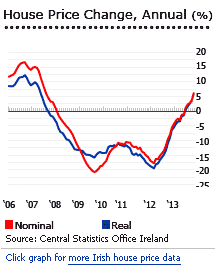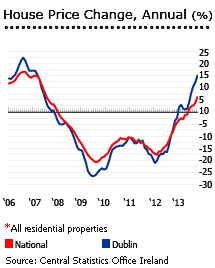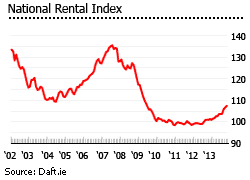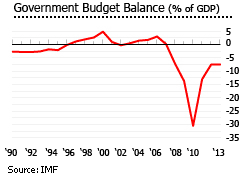Ireland housing market continues to recover, Dublin in mini-bubble?
 Ireland’s housing market continues to recover. The national residential property price index rose by 6.12% (6.01% in real terms) during the year to October 2013, according to Central Statistics Office Ireland. However in the latest Daft.ie report, average transaction prices were up by only 1.9% y-o-y.
Ireland’s housing market continues to recover. The national residential property price index rose by 6.12% (6.01% in real terms) during the year to October 2013, according to Central Statistics Office Ireland. However in the latest Daft.ie report, average transaction prices were up by only 1.9% y-o-y.
The housing market in Dublin is much healthier. The residential property price index in Dublin rose by a whopping 15.02% (14.91% in real terms) during the year to October 2013. This is the tenth consecutive month of growth in residential prices in Dublin, raising concerns over an emerging property bubble in the capital.
Daft.ie again has less aggressive figures, with Dublin’s average asking price rising 7.7% in Q3 2013, the strongest growth since early 2007.
- In Dublin City Centre, the average asking price was €195,777, up by 9.5% during the year to Q3 2013, 54.4% below peak.
- In South County Dublin, the average asking price was up by 12.7% y-o-y to €370,650, 48% below peak.
- West County Dublin’s average asking price up by 3.4% to €170,148, down 55.4% from peak.
- North County Dublin’s average asking price was €210,765, 1.4% higher than the previous year, down 51.9% from peak.
Ireland outside Dublin experienced an average decline of 0.29% (0.39% in real terms) during the year to October 2013. While this was in sharp contrast to October 2012’s 8.90% decline y-o-y, activity remains flat in these areas, suggesting a divide may be emerging between city and country prices.
According to Daft.ie:
- The average residential asking price in Carlow (located in Leinster, eastern part of Ireland) was €117,966, down 15.6% during the year to Q3 2013 and 56.8% below its peak.
- Cork County’s (located in Munster, Ireland’s southernmost region) average asking price was €154,774, down 5.3% y-o-y to Q3 2013 and down 52.4% from the peak.
- Galway County’s (located in Connacht, Ireland’s western region) average asking price was €130,153, down 10.4% y-o-y to Q3 2013 and down 59.7% from the peak.
- Monaghan’s (located in Ulster, Ireland’s northern part) average asking price was €128,282, down 9.9% y-o-y to Q3 2013 and down 60.1% from the peak.
ANNUAL HOUSE PRICE CHANGE, OCTOBER 2013 |
||||||
| Ireland | ||||||
| Dublin | ||||||
| Rest of Ireland | ||||||
| Source: Central Statistics Office Ireland | ||||||
From 1997 to 2007 Ireland experienced a massive house price boom, with price hikes for new houses reaching 216%, and average used home prices increasing by 268%. When the bubble burst in 2008, it was the world’s biggest property bust.
- In 2008, new house prices fell 5.38% y-o-y, and used home prices fell by 7.69% y-o-y
- In 2009, new house prices fell 20.71% y-o-y, and used home prices fell by 21.09% y-o-y
- In 2010, new house prices fell 5.69% y-o-y, and used home prices fell by 0.41% y-o-y
- In 2012, new house prices fell 0.89% y-o-y, and used home prices fell by 5.01% y-o-y
- In 2012, new house prices fell 4.29% y-o-y, and used home prices fell by 4.32% y-o-y
Rating agency Moody´s believes that the long slide in Irish house prices, after seven years, is finally over. Price declines have bottomed out and have been rising since the start of the year 2013.
Ireland’s economy was estimated to have expanded by 0.9% in 2012, and is projected to grow by 1.5% in 2013. The average variable interest rate on new housing loans rose to 3.4% in August 2013, the highest level since December 2012, and outstanding loans for house purchases were 2.2% down in Q3 2013 on the same period the previous year.
Housing boom and bust
Ireland’s house price boom was one of the longest and biggest in Europe.
HOUSE PRICE CHANGE 1996 - 2006 |
||
| IRELAND | ||
| Dublin | ||
| Cork | ||
| Galway | ||
| Limerick | ||
| Waterford | ||
| Others | ||
| Source: DoECLG | ||
The housing boom was originally fuelled by strong economic growth, immigration, and generous tax incentives and grants from the government, creating a virtuous cycle of economic growth and house price increases. Low interest rates and loose credit conditions provided financing.
The situation slowly turned upside down when interest rate hikes started in 2006 and 2007, leaving borrowers in trouble of paying their debts, signalling a housing market crash. The 2006-2007 US subprime mortgage crisis leading to a global financial meltdown in 2008, has worsened the situation making it extremely difficult for Irish banks to recover from their losses.
According to Daft.ie, Ireland has experienced one of the most severe property crashes among modern developed economies. It has been longer than a typical housing market downturn as it marks its 5th year of falling prices last year (2012), as opposed to OECD research’s typical range of four and a half years. Ireland’s crash also proved to have a sharper price decline with an average fall of 53% from its national peak, higher than OECD’s typical fall in prices at 23%.
Dublin in mini-bubble?

The Irish property market extended its recent gains in October, with residential property prices rising 1.76% month-on-month and 6.12% year-on-year. This was the fastest annual growth rate since July 2007 and was entirely driven by the Dublin market. Property prices in the capital were up 2.28% m-o-m and 15.02% y-o-y, while prices outside the capital were up 1.48% m-o-m but were down 0.29% y-o-y.
The figures released by the CSO suggest a sharp rise of almost 10 points in Dublin’s residential property index during the year to October 2013. In large parts of the country, activity remains flat, meaning that a serious divide is emerging between city and country prices.
The “stark divergence” between Dublin and the rest of the country “points to a market currently supported by a lack of supply, with an influx of cash buyers compensating for weak mortgage lending”, according to David McNamara of Davy Stockbrokers.
Property prices in Dublin are now rising faster than they were during the height of the boom. And property experts say that they expect further rises – with an annual increase of 20% expected in Dublin before the end of this year, according to a report by Irish Times.
The Irish Finance Minister Michael Noonan has said there is no need for concern about the hike in property prices in Dublin. "The increase that there is in 2013 is quite small in proportion to the massive drop. There´s no need for concern yet,´´ he said.
"We need property prices to be restored. The trigger point is that they should at least reach on the second hand market the cost of building. It´s an uneconomic situation if the cost of providing accommodation is higher than what you get on the market for second hand property.
The Government is under pressure to ensure enough housing stock is released to avoid another bubble in the capital.
Low interest rates; tighter credit standards

The European Central Bank (ECB) marginal lending rate remains at 1% after it decided to cut its marginal lending rate by 50 basis points from 1.5% to 1% last May 2013.
The variable interest rate for initial rate fixation (IRF) of up to 1 year was 3.4% in August, up from 2.91% in the previous year. Meanwhile, the average interest rate for house purchase loans was at 4.38% in October, up from 4.27% last year.
Interest rates on outstanding mortgages in Ireland have typically reflected movements in the ECB rate. However, recent months have seen a slight divergence among the Ireland and ECB rates.

Loan demand from households for house purchases increased during Q3 2013 – the sixth successive increase. The increase in mortgage demand was linked to more favourable housing market prospects, household savings and higher levels of consumer confidence, according to the latest report by Central Bank of Ireland.
Despite increasing loan demand, lending for house purchase was down by 2.2% during the year to Q2 2013. Outstanding amounts of housing loans are declining, reaching €83.6 billion in Q2 2013, down from €125.1 billion in Q1 2008. The number of approved loans increased by 14.11% for used homes during the year to Q2 2013, but decreased by 4.41% for new houses.
The lower mortgage lending was, in part, due to further tightening of credit standards during the third quarter.
Rising rent yields

The housing crash initially resulted in a huge expansion of rental offers. From 6,200 units in August 2007, the number of properties for rent rose significantly to more than 23,400 in August 2009. In contrast, the stock of rental properties in November 2013 was at its lowest level in six years at above 8,200 units.
Ireland’s rent index was up 6.44% during the year to October 2013, according to Daft.ie, the largest y-o-y increase since July 2007. The national average rent nationwide between April and June 2013 was €842 per month, compared to €804 in the previous year.
Rents outside Dublin rose 1.8% year-on-year, compared to growth of 7.6% in the capital.
Rents in Dublin are rising between 7% to 8% y-o-y. They are still 20% lower than 2007 levels, but 12% higher than 2011 levels.
- In Dublin City Centre, the average rent was €1,176, up by 7.1% during the year to Q3 2013, 20.4% below peak.
- In South County Dublin, the average rent was up by 8.4% y-o-y to €1,331, 17.5% below peak.
- West County Dublin’s average asking price up by 6.3% to €990, down 22.8% from peak.
- North County Dublin’s average asking price was €989, 6.5% higher than the previous year, down 21.4% from peak.
There were only 1,500 units available for rent in Dublin last November 1, the lowest level recorded. Vacancy periods remain very short.
Yields are quite modest in other parts of Ireland.
- Cork County’s average rent was €831, up 3.1% y-o-y to Q3 2013 and down 23.1% from the peak.
- Galway County’s average rent was €816, up 3.6% y-o-y to Q3 2013 and down 15.1% from the peak.
- Limerick City’s average rent was €662, up 1.8% y-o-y to Q3 2013, down 23.3% from peak.
- Waterford City’s average rent was €601, down 1.6% y-o-y Q3 2013 and down 28.6% from peak.
Across the four cities, there were just 1,100 units available for rent on November 1, compared to 1,700 of last year.
Housing starts and completions falling sharply
Dwelling completions tripled during the house price boom to 93,000 units in 2006, from 30,000 units in 1995. However, by the time the bubble burst, the number of completions had fallen sharply to 26,420 units in 2009. Completed dwellings in 2011 were around 10,480 units, and in 2012 only 8,488 units were completed. An even lower number is expected in 2013, with only just 5,682 completions reported from January to October.

Housing starts have also plunged to only 4,042 units in 2012 from 77,691 units of 2004. Housing commencement turnout is also low for 2013 with only 3,238 housing units started.
New property measures
Ireland’s 2012 budget included new property-related tax measures:
- Stamp duty for non-residential property is now down to a flat rate of 2% from its previous rate of 6%, while the current stamp duty arrangements for residential property remains the same. The new rate also applies to farmland.
- Gains from properties bought between December 7, 2011 and December 31, 2012 will be exempted from Capital Gains Tax (CGT) as long as it is held for 7 or more years. The CGT exemption, however, would only be open to properties (residential or commercial) that had been previously acquired during the market’s peak (2005 to 2008) and was sold between December 7, 2011 and end of 2013.
- The Upwards Only Rent Reviews (UORR) provisions (imposing retrospective rent reviews into existing leases) were dropped.
- Mortgage interest relief was increased to 30% for first time buyers who took out their first mortgage from 2004 to 2008. The relief will be available from 2012 to 2017, and all mortgage relief will be abolished by 2018 onwards. First time buyers who purchase in 2012 could also avail a 25% mortgage interest relief, while non-first time buyers could avail it at 15%.
- Ireland’s standard VAT was increased from 21% to 23% starting January 1, 2012.
- A surcharge of 5% will be imposed to individuals obtaining property based tax reliefs with gross income higher than €100,000.
- On January 1, 2012, residential property owners are liable for the household charge on each residential property at €100, and it can be paid in installments.
Ireland ready to exit bailout programme

The Irish housing market collapse in 2008, causing a three-year GDP contraction (-3% in 2008, -7% in 2009 and -0.4% in 2010), and also left banks with bad debt and Ireland with a ballooning deficit. Ireland’s budget deficit ballooned from 7.3% of GDP in 2008, and became the euro zone’s highest deficit in 2010, at 31.2% of GDP.
In order to save the banking sector from collapsing, Ireland had no choice but to seek a €67.5 billion ($82 billion) bailout from the European Union (EU) and the International Monetary Fund (IMF) in November 2010. In exchange, Ireland committed to a harsh austerity program.
The country spent around €80 billion to establish the National Asset Management Agency (NAMA) to acquire toxic loans, primarily with a view to improving the availability of credit in the Irish economy, and to remove uncertainty about non-performing assets on bank balance sheets.
In June 2012, Ireland’s referendum on the EU’s fiscal treaty was passed with 60.29% of voters voting in favor. The referendum endorsing the European fiscal compact on May 31, 2012, resulted in the ratification of a treaty that sets out rules in controlling debt and deficit of euro zone members. This allows Ireland to have an access at the European Stability Mechanism, euro zone’s permanent €500 billion ($618 billion) bailout fund.

Ireland’s efforts bore fruit in 2011 when the country’s deficit went down to 13.1%. The budget deficit fell below 8% in 2012, comfortably within the 8.6% target set by the troika, Ireland’s international creditors from EU, ECB and IMF. The budget deficit is expected to decline further to 7.5% by the end of 2013.
According to the twelfth and final review of troika in November 2013, Ireland is well on its way to exiting the bailout programme, and is expected to be the first European Union country to do so. Once Ireland exits the programme, it will rely solely on the markets for funding.
“Declining unemployment and improving business surveys suggest that the job creation seen in the first half of this year is continuing, which is a crucial element for a revival of domestic demand”, said a statement by the troika.
Ireland has been unwavering in its implementation of the austerity policies mandated by its international creditors. But if Ireland was to meet its declared targets, the troika warned, it would need to slash health and welfare budgets.
After 2.11% growth in 2011, and 0.16% growth in 2012. Ireland’s GDP is expected to rise gradually to 2.52% until 2018, based on forecasts by IMF. However, GDP fell by 1.1% during the year to Q2 2013 due to a drop in personal consumption and net exports.
Personal consumption was down 1.3% y-o-y in Q2 2013. Exports were also down 2.5% y-o-y in October 2013.
The inflation rate was 1.2% in 2011, from -1.6% in 2010, according to the IMF.
In June 2012, unemployment hit its 18-year high of 14.9%, its highest level since March 1994, and up from 4.4% at the peak of the boom. Recent figures from CSO, however, show seasonally-adjusted unemployment rate declined by 11.3% y-o-y in November 2013.